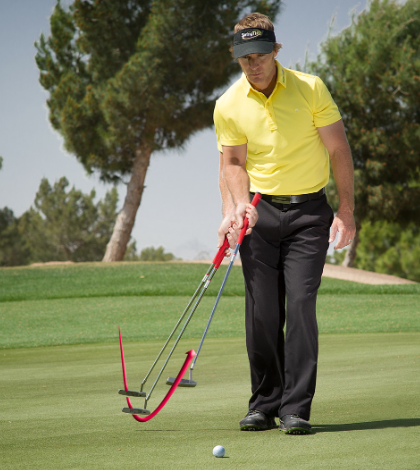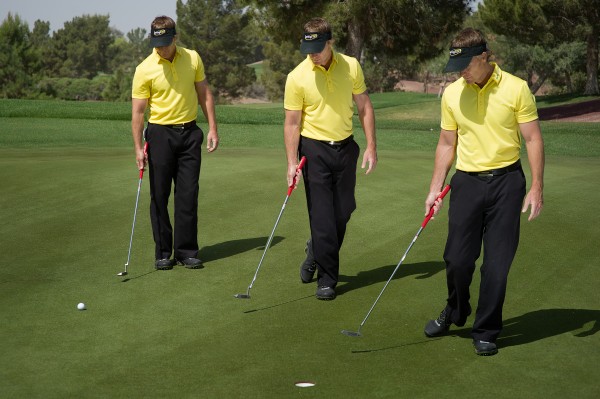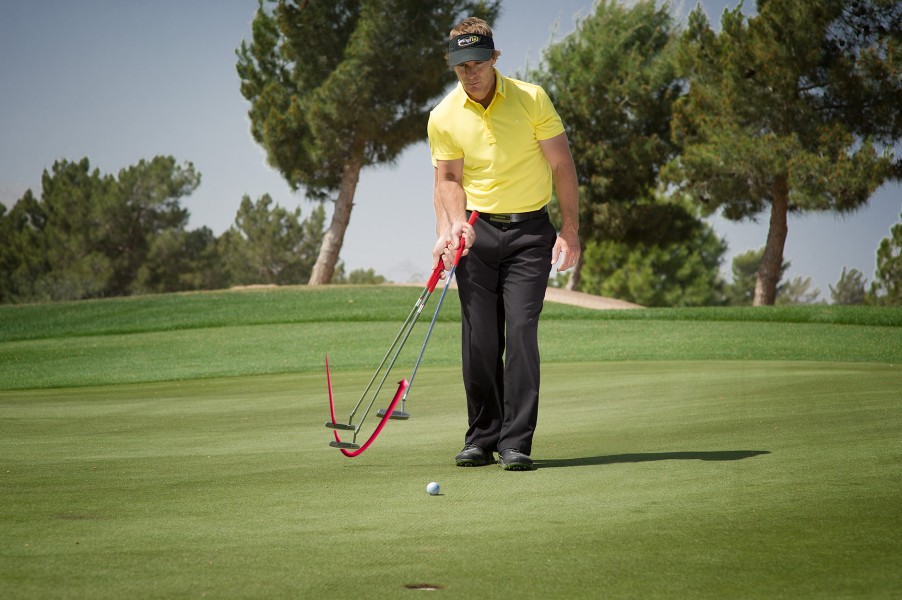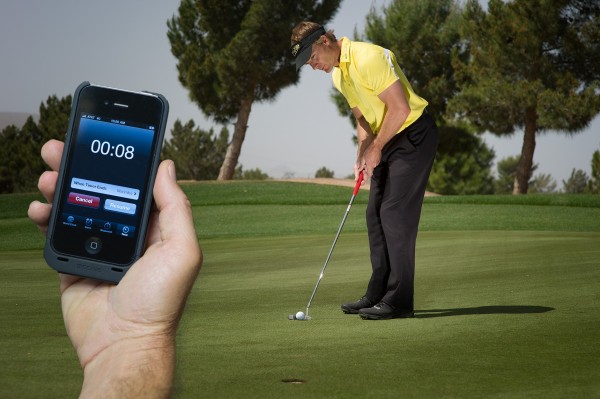Instruction
3 Steps To Lights Out Putting

Early in my coaching career I was obsessed with putting. I was in an environment where I was around a bunch of great players and it became my goal to become the model of putting proficiency. I wanted to be that example to follow and be known as a great putter to other players, as well as my peers.
To tackle my goal, I practiced like crazy. I used every training aid on the market and was consumed with building the perfect-looking stroke. After a couple years of grinding away, my putting officially reached its absolute low point.
“How could this happen?” I thought. I was a great putter as a kid. That’s partially what gave me the confidence to think that I could really be one of the best. I’d figured if I could increase my attention to detail that I’d really be able to take my putting to the next level. In the end, it was my mechanical mindset that literally became my undoing. I was so concerned with “how to stroke” that I lost all connection with the hole and the idea of getting excited about making putts.
To find my putting groove again, I had to learn to let go and focus more on the challenge associated with getting the ball into the bottom of the hole. I had to use my imagination, get into the feeling of making the ball roll, and enjoying the process of being more artist than engineer.
Putting is an area of the game than can be both complex and very simple. Certainly there are times where tuning your mechanics will help elevate your game. However, If you find yourself stuck in a rut and your goal is to simplify your approach, then this story is for you.
Take A Walk
Your first step toward “moss mastery” is learning how to view the hole from different perspectives. You see this a lot with a player like Phil Michelson, who commonly stalks his putt from a variety of angles.
In putting, what you see isn’t always what you get. Very often a putt may look relatively benign when crouched behind the ball in a traditional green reading position, however, once you walk up to the hole you get an entirely different story.
I like to begin by taking a moment to stand right by the hole. I often imagine water coming out of the cup and flowing downhill. This provides the first indication of what kind of putt I’m dealing with.
Once I know which way is downhill, I’ll circle back to the ball’s resting point and take a walk from the ball to the hole. Sometimes I’ll walk low and other times I’ll walk high. Each putt is different. If you walk high, make sure you have a good feeling as to how much break you might be playing, as a walk that’s too low could actually have you damaging your line.
As you survey the landscape really use your imagination and tap into all of your senses. Feel your balance below your feet, noticing any subtle changes in the slope. See the ball curling and diving into the cup at your ideal speed. Find your line and then commit to it. All of this can be done very quickly, so make sure you do a better job of seeing the break without making the game longer.
Find Your Flow
Once you’ve got your line nailed down, it’s time to find your flow. Let go of trying to overly control the path and face and instead focus on feeling the weight of the putter head swinging in rhythm. Try doing this from behind the ball with your eyes level to the ground, gazing down your line to the hole. Here you’re trying to feel the putt “in your gut” versus critiquing every inch of your stroke. Just like rehearsing a bean bag toss in a carnival, stare down your target and feel the putter swinging in silky smooth rhythm. In doing this, my hands are extremely soft on the club, which gives me the best opportunity to tune my senses towards getting that baby to hit rock bottom.
Keep The Feelin’
Now that you’re committed to your line and are pumped to make it, you don’t want to “lose the feeling” by taking too much time over the ball. A good rule of thumb is to putt within eight seconds of your last rehearsal swing.
With your cell phone, set your alarm to count down from eight seconds. At first, just hold the phone in your opposite hand while making rehearsals. Once you’re ready to walk into the ball, start the timer and slide the phone into your pocket. Get set over the ball, take dead aim and pull the trigger. You’ll find that the eight-second gap keeps you moving and focused, eliminating the opportunity to let mechanics and indecision disrupt your positive momentum.
Ben Crenshaw once said, “Putting is an art, not a science.” Although a little science can really help you understand a lot about the game, embracing the fun and creative side of the putting can really help you find your way again!
- LIKE1
- LEGIT2
- WOW1
- LOL0
- IDHT0
- FLOP2
- OB0
- SHANK1
Instruction
The Wedge Guy: The easiest-to-learn golf basic

My golf learning began with this simple fact – if you don’t have a fundamentally sound hold on the golf club, it is practically impossible for your body to execute a fundamentally sound golf swing. I’m still a big believer that the golf swing is much easier to execute if you begin with the proper hold on the club.
As you might imagine, I come into contact with hundreds of golfers of all skill levels. And it is very rare to see a good player with a bad hold on the golf club. There are some exceptions, for sure, but they are very few and very far between, and they typically have beat so many balls with their poor grip that they’ve found a way to work around it.
The reality of biophysics is that the body moves only in certain ways – and the particulars of the way you hold the golf club can totally prevent a sound swing motion that allows the club to release properly through the impact zone. The wonderful thing is that anyone can learn how to put a fundamentally sound hold on the golf club, and you can practice it anywhere your hands are not otherwise engaged, like watching TV or just sitting and relaxing.
Whether you prefer an overlap, interlock or full-finger (not baseball!) grip on the club, the same fundamentals apply. Here are the major grip faults I see most often, in the order of the frequency:
Mis-aligned hands
By this I mean that the palms of the two hands are not parallel to each other. Too many golfers have a weak left hand and strong right, or vice versa. The easiest way to learn how to hold the club with your palms aligned properly is to grip a plain wooden ruler or yardstick. It forces the hands to align properly and shows you how that feels. If you grip and re-grip a yardstick several times, then grip a club, you’ll see that the learning curve is almost immediate.
The position of the grip in the upper/left hand
I also observe many golfers who have the butt of the grip too far into the heel pad of the upper hand (the left hand for right-handed players). It’s amazing how much easier it is to release the club through the ball if even 1/4-1/2″ of the butt is beyond the left heel pad. Try this yourself to see what I mean. Swing the club freely with just your left hand and notice the difference in its release from when you hold it at the end of the grip, versus gripping down even a half inch.
To help you really understand how this works, go to the range and hit shots with your five-iron gripped down a full inch to make the club the same length as your seven-iron. You will probably see an amazing shot shape difference, and likely not see as much distance loss as you would expect.
Too much lower (right) hand on the club
It seems like almost all golfers of 8-10 handicap or higher have the club too far into the palm of the lower hand, because that feels “good” if you are trying to control the path of the clubhead to the ball. But the golf swing is not an effort to hit at the ball – it is a swing of the club. The proper hold on the club has the grip underneath the pad at the base of the fingers. This will likely feel “weak” to you — like you cannot control the club like that. EXACTLY. You should not be trying to control the club with your lower/master hand.
Gripping too tightly
Nearly all golfers hold the club too tightly, which tenses up the forearms and prevents a proper release of the club through impact. In order for the club to move back and through properly, you must feel that the club is controlled by the last three fingers of the upper hand, and the middle two fingers of the lower hand. If you engage your thumbs and forefingers in “holding” the club, the result will almost always be a grip that is too tight. Try this for yourself. Hold the club in your upper hand only, and squeeze firmly with just the last three fingers, with the forefinger and thumb off the club entirely. You have good control, but your forearms are not tense. Then begin to squeeze down with your thumb and forefinger and observe the tensing of the entire forearm. This is the way we are made, so the key to preventing tenseness in the arms is to hold the club very lightly with the “pinchers” — the thumbs and forefingers.
So, those are what I believe are the four fundamentals of a good grip. Anyone can learn them in their home or office very quickly. There is no easier way to improve your ball striking consistency and add distance than giving more attention to the way you hold the golf club.
More from the Wedge Guy
- The Wedge Guy: Golf mastery begins with your wedge game
- The Wedge Guy: Why golf is 20 times harder than brain surgery
- The Wedge Guy: Musings on the golf ball rollback
- LIKE83
- LEGIT13
- WOW5
- LOL1
- IDHT0
- FLOP4
- OB1
- SHANK8
Instruction
Clement: Stop ripping off your swing with this drill!

Not the dreaded headcover under the armpit drill! As if your body is defective and can’t function by itself! Have you seen how incredible the human machine is with all the incredible feats of agility all kinds of athletes are accomplishing? You think your body is so defective (the good Lord is laughing his head off at you) that it needs a headcover tucked under the armpit so you can swing like T-Rex?
- LIKE0
- LEGIT2
- WOW2
- LOL0
- IDHT0
- FLOP0
- OB0
- SHANK2
Instruction
How a towel can fix your golf swing

This is a classic drill that has been used for decades. However, the world of marketed training aids has grown so much during that time that this simple practice has been virtually forgotten. Because why teach people how to play golf using everyday items when you can create and sell a product that reinforces the same thing? Nevertheless, I am here to give you helpful advice without running to the nearest Edwin Watts or adding something to your Amazon cart.
For the “scoring clubs,” having a solid connection between the arms and body during the swing, especially through impact, is paramount to creating long-lasting consistency. And keeping that connection throughout the swing helps rotate the shoulders more to generate more power to help you hit it farther. So, how does this drill work, and what will your game benefit from it? Well, let’s get into it.
Setup
You can use this for basic chip shots up to complete swings. I use this with every club in my bag, up to a 9 or 8-iron. It’s natural to create incrementally more separation between the arms and body as you progress up the set. So doing this with a high iron or a wood is not recommended.
While you set up to hit a ball, simply tuck the towel underneath both armpits. The length of the towel will determine how tight it will be across your chest but don’t make it so loose that it gets in the way of your vision. After both sides are tucked, make some focused swings, keeping both arms firmly connected to the body during the backswing and follow through. (Note: It’s normal to lose connection on your lead arm during your finishing pose.) When you’re ready, put a ball in the way of those swings and get to work.

Get a Better Shoulder Turn
Many of us struggle to have proper shoulder rotation in our golf swing, especially during long layoffs. Making a swing that is all arms and no shoulders is a surefire way to have less control with wedges and less distance with full swings. Notice how I can get in a similar-looking position in both 60° wedge photos. However, one is weak and uncontrollable, while the other is strong and connected. One allows me to use my larger muscles to create my swing, and one doesn’t. The follow-through is another critical point where having a good connection, as well as solid shoulder rotation, is a must. This drill is great for those who tend to have a “chicken wing” form in their lead arm, which happens when it becomes separated from the body through impact.
In full swings, getting your shoulders to rotate in your golf swing is a great way to reinforce proper weight distribution. If your swing is all arms, it’s much harder to get your weight to naturally shift to the inside part of your trail foot in the backswing. Sure, you could make the mistake of “sliding” to get weight on your back foot, but that doesn’t fix the issue. You must turn into your trial leg to generate power. Additionally, look at the difference in separation between my hands and my head in the 8-iron examples. The green picture has more separation and has my hands lower. This will help me lessen my angle of attack and make it easier to hit the inside part of the golf ball, rather than the over-the-top move that the other picture produces.


Stay Better Connected in the Backswing
When you don’t keep everything in your upper body working as one, getting to a good spot at the top of your swing is very hard to do. It would take impeccable timing along with great hand-eye coordination to hit quality shots with any sort of regularity if the arms are working separately from the body.
Notice in the red pictures of both my 60-degree wedge and 8-iron how high my hands are and the fact you can clearly see my shoulder through the gap in my arms. That has happened because the right arm, just above my elbow, has become totally disconnected from my body. That separation causes me to lift my hands as well as lose some of the extension in my left arm. This has been corrected in the green pictures by using this drill to reinforce that connection. It will also make you focus on keeping the lead arm close to your body as well. Because the moment either one loses that relationship, the towel falls.


Conclusion
I have been diligent this year in finding a few drills that target some of the issues that plague my golf game; either by simply forgetting fundamental things or by coming to terms with the faults that have bitten me my whole career. I have found that having a few drills to fall back on to reinforce certain feelings helps me find my game a little easier, and the “towel drill” is most definitely one of them.
- LIKE12
- LEGIT2
- WOW2
- LOL0
- IDHT0
- FLOP2
- OB0
- SHANK8
-

 19th Hole2 weeks ago
19th Hole2 weeks agoJohn Daly stuns fans into silence with brutal opening tee shot on PGA Tour Champions
-

 19th Hole1 week ago
19th Hole1 week agoThings got heated at the Houston Open between Tony Finau and Alejandro Tosti. Here’s why
-

 19th Hole2 days ago
19th Hole2 days agoTiger Woods arrives at 2024 Masters equipped with a putter that may surprise you
-

 19th Hole24 hours ago
19th Hole24 hours agoDave Portnoy places monstrous outright bet for the 2024 Masters
-

 19th Hole1 week ago
19th Hole1 week agoReport: Tiger Woods has ‘eliminated sex’ in preparation for the 2024 Masters
-

 19th Hole2 weeks ago
19th Hole2 weeks agoCharlie Woods finds it tough going on American Junior Golf Association debut
-

 19th Hole1 week ago
19th Hole1 week agoAddiction, spinal fusion, and scam artists – Everything Anthony Kim revealed in candid interview with David Feherty
-

 19th Hole6 days ago
19th Hole6 days agoAnthony Kim says doctors told him that he ‘may not have much time left’ ahead of LIV return






























Dr. Jeff Eger
Jun 12, 2013 at 11:00 pm
You have discovered mental golf gives you the small tight picture,lose your flow or automaticity,dissolve imagination.When you see efficiently(in all 7 visual skills and my 6 step ocular set up) then you see EZ-trust it-Feel it(intuition)-trust it and do it.The big picture lets you see slightly ahead of real time(Zen like).Please read all my wesite if you have an open mind and truly want to be an efficient putter like you were as a kid.All consistant champions are “feel Players”,that I have worked with.When you think you have lost the feel.
David
Apr 25, 2013 at 10:39 am
Nice read, Jeff. I personally find making long putts to be one of the three most enjoyable shots in the game, along with pulling the string on a pured short iron, and the feeling of a well struck long iron. I love the idea of the timer in the pocket during practice as I believe that most putts are missed before the stroke even takes place.
Sebastian Zander
Apr 18, 2013 at 2:19 am
“Let go of trying to overly control the path and face and instead focus on feeling the weight of the putter head swinging in rhythm.” — I guess controlling the path and face is what most likely makes my putts miss the hole so often. I’ll have to change my mindset and learn to commit to my line. Feeling the weight of my putter might just be the perfect thought for focussing. I will give this one a try the next time I’m on the putting green. Thanks.
– Sebastian